|
|
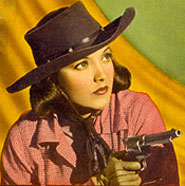 NELL O’DAY NELL O’DAY
by Guest Columnist Bob Pontes
The Universal series in which Nell O’Day co-starred with Johnny Mack Brown is considered by many B-western enthusiasts to be among the best ever filmed. The diminutive 5' 3" actress painted a picture of fast action, riding Shorty, her sorrel steed across the silver screen alongside Johnny Mack Brown. This remembrance is composed from Bob Pontes’ 1983 interview with Nell and personal letters written by Nell. Nell was born in her grandmother’s house in Prairie Hill, TX, but lived in Dallas until she was seven when they moved to L.A. where her father, an auditor with the Texas and Pacific Railroad, died less than a year later. Her mother became a professional photographer and worked with some of the best photographic studios in Hollywood, becoming an expert photographic retoucher.
NO: I was fortunate enough, before my 10th birthday, to be offered a splendid engagement in the theatre as a dancer. I had worked very hard as a ballet dancer during my childhood and had a marvelous teacher, Ernest Belcher, step-father to Lina Basquette and father of Mary Champion, of Marge and Gower Champion fame. I went on to many interesting engagements in live theatre, as leading lady and ingenue. When I was 18 I joined a group of six young men as the only girl in a singing/dancing act. We played one winter at the Oriental Theatre in Chicago. The musical director was Victor Young who later became director of the music department at MGM. These were miniature musical comedies and revues that ran for about 50 minutes between the films. The shows changed every week. From the Chicago engagement, I was signed with the Tommy Atkins Sextet to be featured in John Murray Anderson’s “Laces and Graces” which took us on a tour of 28 weeks through most of the U.S. Then back to Hollywood to fill a contract in the musical film “King of Jazz” starring Paul Whiteman. Shortly after, I was given the ingenue role in the Broadway musical “Fine and Dandy” starring Joe Cook, a very successful musical that ran for a year and a half. From that I signed a contract with Fox where I made several films and returned to New York to appear in several plays during the following five years, as well as some of the leading summer stock companies of the Eastern Seaboard. When I was playing in Broadway shows in New York I sometimes made industrial films during the day and played the theatre at night. I signed a contract with WB and returned to Hollywood. Later, I signed a contract with Universal.
BP: How were you selected to co-star with Johnny Mack
Brown?
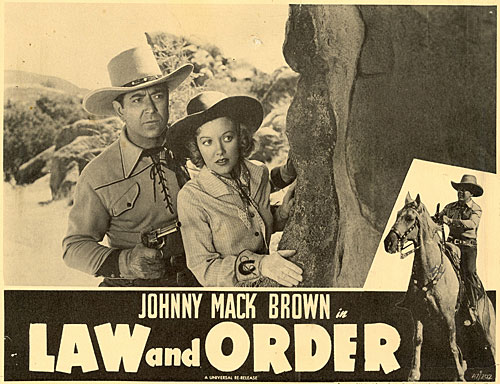
NO: I had lots of training when I tried out at Universal. The studio was looking for a “dainty tomboy”. I stood only 5' 3", and had good agility and coordination due to all my dancing. They tried out about a dozen actresses, and I was chosen. Would you believe they signed me and didn’t even ask if I could ride a horse? Luckily, I had been riding since I was a child. I love horses and all animals. Johnny Mack Brown rode a big palomino, Reno; my horse was Shorty, a sorrel with white stockings and a blaze forehead. Fuzzy Knight’s horse was Old Brownie. Reno and Shorty were very good friends and liked working together. There were no thoroughbreds, these were all working horses, correct for the period of the films. I talked to Shorty when I first met him then put a kiss on his white nose. How the wranglers laughed! I always did that at the beginning of each film. Then once, just before the first shot of a movie that involved my getting on Shorty and riding away, one of the wranglers said, “Aren’t you going to kiss Shorty?” So they weren’t so tough, after all. They would have been disappointed if I hadn’t kissed him. I don’t think anyone could have liked him more than I did. Most of the films I made at Universal were with a very fine stunt rider, Babe DeFreest. She doubled many well known actresses. Johnny Mack and I sometimes did our own stunts, although that was not generally known. Making films with horses is very exacting: stopping on the right mark for the cameraman, holding one’s horse to the right pace with the camera car during running inserts, making a hurried exit from a building with several actors, mounting horses at approximately the same time and galloping out of town. I think our horses liked making movies. We did not own these horses, they were rented from a stable that specialized in ‘actor-horses’.
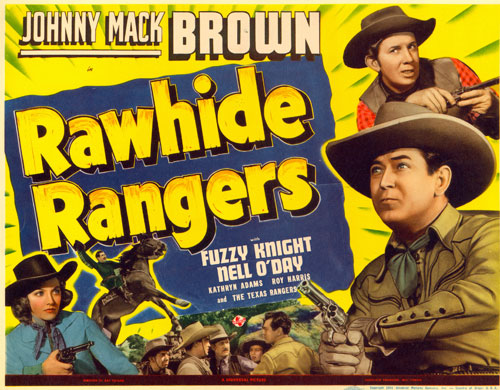
BP: Ever any injury to you doing those stunts?
NO: No. I was never injured. Johnny Mack Brown was a splendid athlete—a fine horseman and, in his earlier life, a star football player. I was an experienced horsewoman, so all of the stunts we did together worked out very well. We did several scenes in which I transferred from my horse to Johnny Mack’s great palomino and several in which Johnny Mack stopped the wagon which was running away, with me climbing out on to the lead horse. We worked out all of those stunts very carefully—and nothing ever went wrong. During the filming of the Columbia serial, “Perils of the Royal Mounted”, I was scraped off my horse while riding fast down a slope. This was actually the fault of the director, James W. Horne. He thought a rehearsal for this rather dangerous ride was unnecessary. Most directors familiar with outdoor films and horses insist on rehearsals for these scenes so the horse can walk through the scene. Horne was probably in indifferent health during the filming of this long serial. He had been making films for many years and died only days following the completion of “Perils”.
BP: Louise Stanley co-starred in “The Oregon Trail” in 1939. In an interview she said Johnny Mack Brown was certainly no horseman. What do you think of his horsemanship?
NO: I had a long experience with Johnny as the star of 13 westerns. I do not know what Louise Stanley’s film consisted of, but I surely can speak for my own memories with Johnny Mack Brown. He was a superb horseman, certain and sure in all of his riding. We made many running inserts together and sometimes performed our own stunts. He had been a member of a Hollywood polo team and gave up that interesting sport because his wife thought it was too dangerous, which it was. But he certainly was a very good horseman.
BP: Who was the most fun to work with—and why?
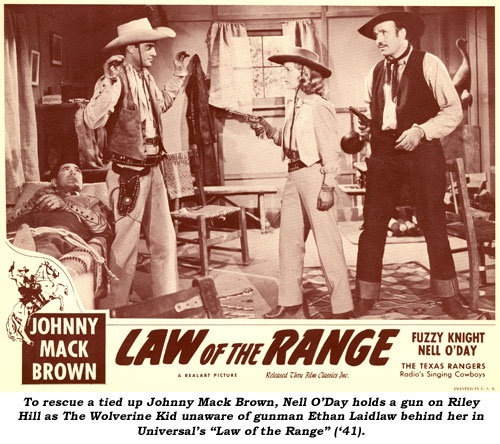
NO: Almost without exception, all of the actors and actresses I worked with have been easy to get along with. Johnny Mack was a very skillful rider and an experienced actor, relaxed and easy, always knew his lines. A Southerner, he had easy, courteous manners. He had a quick and keen sense of humor and was very well liked by all his co-workers, which is no surprise; he was a charming man. Fuzzy Knight was such a lovable part of our casts—always fun and delightful. He and I sometimes sang songs in those westerns. He had played in the theatre and night clubs years before. Harry Cording was a great heavy and a man with an interesting background. He had been one of the highest non-commissioned officers in His Majesty’s Army, stationed at Gibraltar (which he always called Gib) for years and had many colorful stories to tell of his life in the British service. Nearly all of the character men had at some time during their careers played in some musical act in vaudeville. In between shots they used to get together and sing wonderful barber-shop harmony. I shall always remember those talented and delightful men getting together and entertaining all of us. Sometimes I joined them (the only soprano) and so would Fuzzy Knight, who could always hold his own, and Johnny Mack with his beautiful baritone. Some of the ‘heavies’ were very witty and full of good times off camera. Most of the actors and actresses I have known think of the people they have worked with almost like a family. This was true of Johnny Mack Brown, Fuzzy Knight, our grand directors…Ray Taylor and Ford Beebe, our grand technicians and myself—because we made two series of films as a “family”. Tim Holt was delightful too. He also was a good rider and a good actor. We played the children of Charles Boyer in the second version of “Back Street” and played opposite each other in RKO’s “Pirates of the Prairie”. An easy and experienced actor, always as attractive and charming as he appeared to be in his films. He always had a twinkle in his eyes and was very popular with the cast and crew.
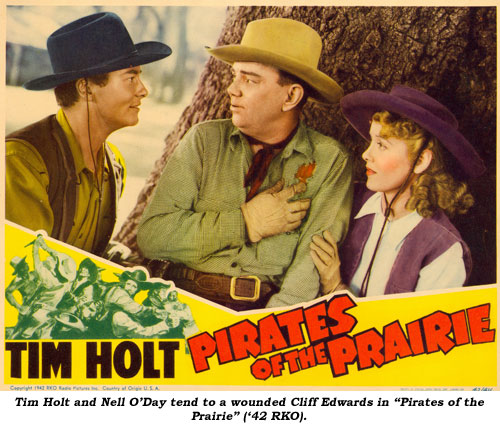
I made only one film with Bob Steele although I had known him years before when we used to double-date (with other people). He grew up in Hollywood but he had a feeling of the old West about him. He had a sort of wonderful 19th Century face. I think Bob Steele had more finesse and style in his riding than anyone. It would be very hard to choose one favorite character actor. They have always been the backbone of the profession. I loved John Elliott who played my father more than once. He had had years of experience and was gentle and kind with everyone. Herbert Rawlinson had been a handsome, famous leading man during silent film days. He was just as conscientious and talented in his roles as a character man—a good villain too when the part called for it. Kermit Maynard was a very quiet, courteous man. He always impressed me with his upright character. Glenn Strange was a marvelous type for his parts. He played heavies in most of the films I made with him, but his long run in “Gunsmoke” showed a different side to his character. One day his wife brought their tiny daughter to the set and I saw the tenderness in Glenn’s eyes when he picked her up and held her close. My favorite directors in films were Ray Taylor, Ford Beebe and Luther Reed. Ray was never nervous, always believed his actors could do what he asked them to do and had a genuinely wry and funny sense of humor. Once, after the commencement of the U.S. participation in the Second World War, there were planes overhead that spoiled the shot being made. Ray looked up at the sky and made a wide beckoning gesture to the Air Force planes, shouting, “Thank goodness, you’re more important than the front office of Universal Studio!” Ford Beebe was a quiet, gentle man who was also a good director. He made the tests of the seven or eight actresses testing for that long series of westerns with Johnny Mack Brown. Reed had been a silents director but I worked with him in several films in New York. Sometimes I would have only two or three days off between films, sometimes several weeks, but they were filled with taking publicity pictures or a personal appearance in a local theatre or at some special function like the Hollywood Blvd. Christmas parade or “Pioneer Day”. There was always the business of getting costumes fitted, studying and memorizing roles.
BP: You made “Arizona Stagecoach” with the Range Busters.
NO: Monogram was not my “home” studio but I enjoyed making that film very much. There were other old friends in the cast, Kermit Maynard, Charles King, Stanley Price. I met Ray Corrigan from time to time because he had a grand ranch which he rented to the studios. I saw him many years later at the Western Film Fair at the Biltmore Hotel in L.A. in 1976. We had a long talk about some of our old friends, caught up on the events of our own lives since we had worked together. It was a sadness when he passed away only weeks after the 1976 Western Film Fair.
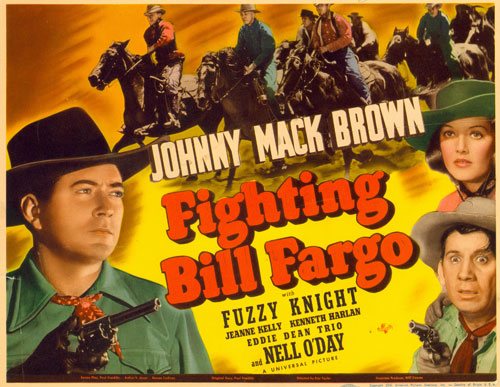
BP: Did you find many differences between working for Universal and PRC or Monogram?
NO: The greatest difference was in the size and importance of the studios. I was under a long-term contract to Universal which had a large company of contract players, directors, cameramen, a large lot with many sets and other conveniences, such as a still photo studio, comfortable dressing rooms, a large and well-equipped wardrobe department. PRC was a much smaller studio. The actors who played in their films, however, were very good indeed.
BP: What was a typical day for you at Universal?
NO: The outdoor scenes were always shot first. At that time, I owned a house in Reseda in the San Fernando Valley which was en route to our locations, over the Santa Susanna Pass or Iverson’s or Corrigan’s Ranch. I was picked up at home by the studio limousine which already contained several actors who had started from the studio. I got up at 5 AM and already had my makeup on when the studio car arrived. We were all ready to shoot soon after sun-up. There was always a chuck wagon that served coffee, tea and breakfast. Lunches were catered and were very good indeed. We worked until sundown. The guns used in our films were valuable antiques from the post Civil War period. They were kept in perfect condition for us by the property department who also carefully collected them from all the actors in particular scenes. The guns worn when we were riding were rubber copies to avoid accidents and prevent serious injuries if an actor fell from his horse. The interiors for these films were shot on the stages of Universal as were all of the street scenes. In some ways, the interiors were less difficult to make but also less interesting. In the spring there were wild flowers everywhere on the country locations and birds building their nests. Once, a large colony of Capistrano swallows returned to build their beautiful little mud nests and we had to abandon the old Spanish hacienda where we were supposed to shoot. The swallows won!
BP: How did you get paid when making a film?
NO: All contract players were paid weekly, so were free-lance players. All actors had agents who arranged their contracts, their salaries and other business matters. Actors’ salaries were always kept as secret as possible.
BP: How long did each western film take to make?
NO: The time schedule varied. Most of the westerns in which I appeared took from ten days to three weeks.
BP: Did you see your films just after their completion?
NO: Sometimes it was possible but not always practical because actors were scheduled to go on location for another film. Sometimes there were special “Previews” at some theatre when actors made personal appearances. My own schedule of work was such a busy one I was never able to see the rushes or dailies.
BP: Why did you leave films?
NO: I left Hollywood and film making after I married Larry Williams, who was then an actor. He became ill (tuberculosis) and was an invalid for many years. I played in a number of New York plays and some TV during the times my husband was well. Larry became a successful writer using his given name, Lawrence Williams. We have been divorced for many years. Larry Williams and I wrote two film “originals” and sold them. One of the “originals” was “The Monster Maker” in which Ralph Morgan played a famous concert pianist. The story was absurd and fantastic. We had fun writing it. The other story was called “Double Trouble” while we were writing it but I have a dim recollection the title was changed when it was released. It was a suspense-mystery and had one or two of the original Dead-End Kids in the cast. I never saw it.
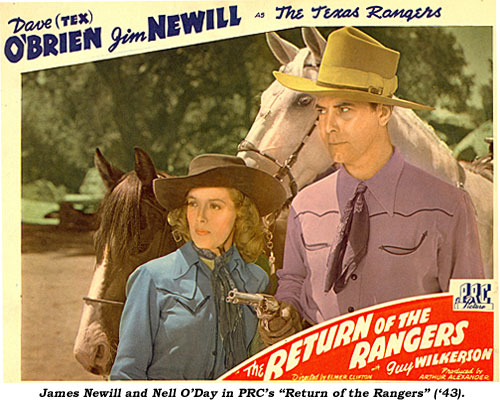
BP: Were you married again?
NO: Yes, but I have no children.
BP: What have you done since you left Hollywood?
NO: I went to England in 1952 because Lawrence Williams and I had written an historical play that was produced at the Royal Court Theatre in London, “The Bride of Denmark Hill”. Later I lived in Italy, Sicily and England. I was writing for various publications during those years. During the past 16 years I have been an editor for several publications…ITT Cannon Electric, which was principally technical writing, and an International publication, WORLD DREDGING AND MARINE CONSTRUCTION. It all came about because I had written stories and articles for magazines (REDBOOK, COLLIERS etc). I took some university courses in New York and at UCLA and that led from one thing to another. I am still writing. I have written some art gallery brochures and some book reviews for three different professors. I always write under my own name. I hope to find time to write some novels and more short stories. I shall always remember all the grand people I worked with—many of whom are now gone.
One of the first ladies of B-Westerns, Nell O’Day, is also now gone, dying January 3, 1989, of cardiac arrest. She was 79.
Nell’s Western Filmography
Movies: Smoke Lightning (‘33 Fox)—George O’Brien; Son of Roaring Dan (‘40 Universal)—Johnny Mack Brown; Ragtime Cowboy Joe (‘40 Univ.)—Johnny Mack Brown; Law and Order (‘40 Univ.)—Johnny Mack Brown; Pony Post (‘40 Univ.)—Johnny Mack Brown; Boss of Bullion City (‘41 Univ.)—Johnny Mack Brown; Bury Me Not On The Lone Prairie (‘41 Univ.)—Johnny Mack Brown; Law of the Range (‘41 Univ.)—Johnny Mack Brown; Rawhide Rangers (‘41 Univ.)—Johnny Mack Brown; Man From Montana (‘41 Univ.)—Johnny Mack Brown; Masked Rider (‘41 Univ.)—Johnny Mack Brown; Arizona Cyclone (‘41 Univ.)—Johnny Mack Brown; Fighting Bill Fargo (‘41 Univ.)—Johnny Mack Brown; Stagecoach Buckaroo (‘42 Univ.)—Johnny Mack Brown; Arizona Stagecoach (‘42 Monogram)—Range Busters; Pirates of the Prairie (‘42 RKO)—Tim Holt; Thundering Trails (‘42 Republic)—3 Mesquiteers; Return of the Rangers (‘43 PRC)—James Newill/Dave O’Brien; Boss of Rawhide (‘43 PRC)—James Newill/Dave O’Brien. Serial: Perils of the Royal Mounted (‘42 Columbia)—Robert Stevens (Kellard).
top of page |

